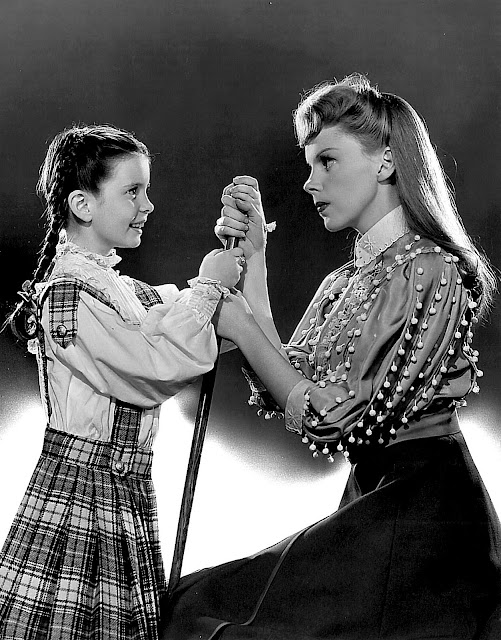Part Two of Meet Me In St. Louis
My greatest pleasure in
As it is, we get the impression that the Braukoffs have run out of patience with Kensington Avenue youth well before Tootie comes knocking at their door. In view of the couple's standing among neighbors, it probably comes as no surprise to Mr. Braukoff that she would throw flour in his face. For characters that appear so fleetingly, I’ve expended more thought on the Braukoffs than anyone else in Meet Me In St. Louis, maybe just for having encountered so many ominous (and maybe misunderstood?) figures like them.
 |
| Vincente Minnelli Directing The Halloween Sequence |
Halloween concludes with a nicely disturbing segment wherein Tootie accuses John Truett of tearing open her lip. Meet Me In St. Louis at this point seems to be spiraling toward dark direction as the child recounts what sounds like a molestation by a boy next door we’re still not quite sure about (after all, he’s made no move to kiss Esther, despite her invitation). John’s exoneration is slow in coming. We spend nearly a reel imagining the worst. For having caused the mess, Tootie becomes herself a reasonable candidate for intervention. Such hysterical behavior and subsequent tearful business as knocking down snow people would today be addressed by way of Lithium or Zoloft regimen, putting paid to talk of doll cemeteries and rivers filled with dead bodies. Result: a twenty-first century Tootie neatly lobotomized and no further cause for family alarm.
I’m still not past this business of Rose dating her brother to the Christmas dance. The way it’s set up is distinctly creep-inducing. Did these actors realize their characters were siblings? Henry H. Daniels plays Lon. This was his first film. There wouldn’t be many more, and few of those saw him credited. Daniel’s line readings are weirdly fey. When he’s finally persuaded to ask his sister to the prom, they both play it way too boy-girl for comfort. It’s always fun watching first-time viewers squirm a little during all this. Then there’s the added fill-up of Esther being fitted for her corset in the next scene. Turn off the picture and just listen to the sound next time. It’s as close as you’ll get to a moment of Judy ecstasy beyond what she conveyed singing on stage and screen.
Why couldn’t John simply borrow Grandpa’s tuxedo? That would have been too cruel, I know, but the thought always occurs to me. As it is, the old man has the number of every geek and social outcast in
Have Yourself A Merry Little Christmas as sung by Judy makes me a little weepy even when I hear it in the car. As lead-up to the big emotional meltdown and cathartic finish of Meet Me In St. Louis, this is the song remembered best from the film. That it’s become a Yule standard helps too. Part of my enduring sentiment for MMISL comes of having lucked into a brand new 16mm print in late autumn of 1976. To own such a blockbuster was as intoxicating as Christmas morning itself, especially as we scarcely had
MGM's St. Louis street would serve as backlot shrine and setting for nostalgic themes explored by filmmakers to come. One of them was Rod Serling, who walked down Kensington and saw visions of his own











